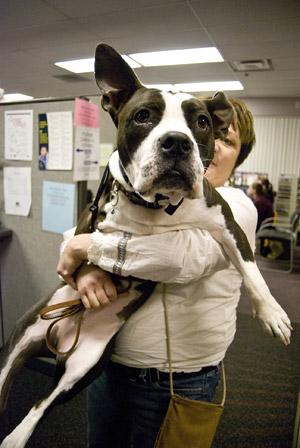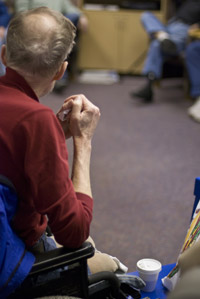Web ExclusiveLimb-Loss Support Group Gets a Leg Up — With Lefty  Sometimes a surgeon speaks them. Sometimes a nurse or a family member utters them. Occasionally, the patient is the one who speaks those four crucial words: “The leg must go.” The impact of these four words—and the amputation that follows—is profound. A body is changed; life takes an unexpected turn. These four words may induce months of depression. These words may finally bring closure to an endless cycle of surgeries. These words have the power to unite families, destroy marriages, or foster new friendships. These words may even result in self-discovery; as one recent amputee described it, “I never knew how many muscles I had in my butt.” Four words may send a person to the operating table, but countless questions remain. Will I walk again? What will my prosthesis look like? Do I have to tell my boss? What about that two-year gap on my résumé? People who have had amputations face new challenges and doubts. Simply walking across the room becomes an impossible dance with a titanium robot. Extension cords and uneven steps become new archrivals. Fortunately, University of Michigan (U-M) Health Systems in Ann Arbor has developed a unique solution for helping patients confront life with one limb less: a limb-loss support group. A Family Reunion of Sorts Amid all the conversations, a hush creeps into the room as the police officer begins to tell a story. He tells about how, while working the graveyard shift a few years ago, he approached a man illegally parked in a handicap spot. “Come on man, there aren’t any handicapped people out at this time of night” was the man’s excuse. The officer rolled up his right pant leg and both men stared at the titanium shaft that is his leg. Unrolling his pant leg, he asked the man, “Where should we be at this time of night?” Everyone in the room nods in approval. Stories like this seem to give the group fuel to continue living and loving life after limb loss. Depression, the Common Enemy in the Room The hospital realized that when the anesthesia fades, depression is typically at the bedside to wake up the patient. Many members in the group struggled with depression both before and immediately after their amputations. “I am glad that I didn’t do what I thought I was going to do,” said one group member recalling the days immediately following his amputation. When an arm or a leg comes off, everything changes. Familial chaos ensues when the person who is a family’s main source of income is unable to work. A fresh amputation stands between old friends who used to play touch football or spend time gardening together. Issues of depression and life adjustments are outside the realm of a surgeon’s work (let’s be honest, surgeons are called “sawbones” for a reason). On an amputation surgery, their sole objective is to remove the faulty appendage. When the last stitch is tied, the limb-loss support group and its professional leaders take over. Two Leaders, One Objective The goal of the support group is to accompany patients through the entire process of living with an amputation. Mote prefers to work with the patient prior to surgery. “Amputation is a tough process to go through … to realize that life has changed. There is certainly a grieving process and it is a very individual process for everybody,” she explains. Either Mote or Kelly will meet with the patient in the hospital prior to amputation to answer questions and calm fears. Some patients are very quick to connect with a support group; others are more reluctant to meet with others who have had amputations. “Some people may take years before they are comfortable going to an amputee support group,” Kelly explains. Although both have different backgrounds, Mote and Kelly function symbiotically as group leaders. As a clinical social worker, Kelly specializes in issues such as resource concerns and mental health. Mote, on the other hand, draws from her own experience of having lost a limb, as peer support and lifestyle education are her forte. An Assault on Life’s Misfortunes Still something keeps the group members going. Many wear their prosthetic leg like a badge. They beat those fateful four words and they are proud to show it. Their prosthetic leg is the marriage of art and science, a medley of titanium and carbon fiber united together in an assault on life’s misfortunes. It is strange to walk into a limb-loss support meeting and hear laughter rather than tears. Where do their high spirits come from? It may be from the camaraderie of the group. Perhaps it is in the group’s well-trained and resilient social worker and limb loss coordinator. The goofy three-legged dog rolling around at their meetings may keep them going. Maybe it is a little bit of everything—fellow amputees, dedicated leaders, three-legged dog kisses—that keeps them going. — A. Trevor Sutton is a freelance writer based in St. Louis. (Photos by Seth Hinz) |

 Funded jointly by the U-M Cardiovascular Center and the U-M Orthotics and Prosthetics Center, it is the hospital’s way of recognizing that its job does not end on the operating table; life after amputation only begins when a limb comes off. The group meets monthly and addresses an array of topics pertaining to life after limb loss. Conversations range from cooking with one arm to the serious matter of amputation-induced depression.
Funded jointly by the U-M Cardiovascular Center and the U-M Orthotics and Prosthetics Center, it is the hospital’s way of recognizing that its job does not end on the operating table; life after amputation only begins when a limb comes off. The group meets monthly and addresses an array of topics pertaining to life after limb loss. Conversations range from cooking with one arm to the serious matter of amputation-induced depression. 